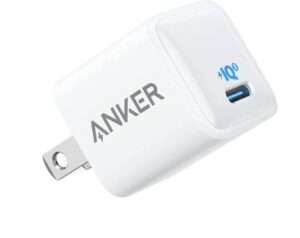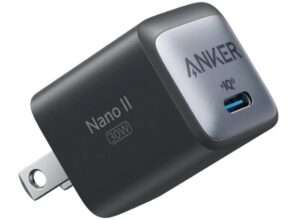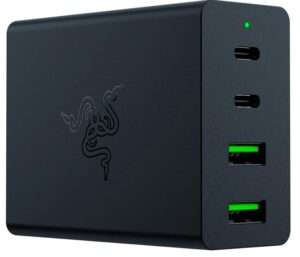There is no doubt that a fast charger will be able to recharge your headphones. In comparison with traditional chargers, fast chargers are designed to provide a higher amount of power, which allows your headphones to be charged more quickly than before.
While it is very helpful that your headphones be able to be charged quickly, you should make absolutely certain they are compatible with quick charging. To be on the safe side, you should always make sure that you are using the correct type of fast charger for your specific model of headphones.
For the purpose of ensuring the safety and effectiveness of your fast charger, you should also carefully follow the instructions provided by the manufacturer. This is so that you can be sure that you are using it correctly and in a safe manner.
How to use a fast charger to charge your headphones
In this Topic we will cover:-
- What Is Fast Charging?
- How Much Faster is it compared to a Regular Charger?
- How Does Fast Charging Work?
- Is Fast Charging Safe?
- Can You Fast Charge All Batteries?
- What Do You Need for Fast Charging?
- USB Charging Standards
- Types of Fast Charging Standards
- Does Fast Charging Matter for Headphones?
- The Future of Fast Charging
1. What Is Fast Charging?
The term “fast charging” refers to a technology that, when applied to a device like a smartphone or an electric vehicle, makes it possible to charge it more quickly than with a traditional charger.
The device is typically charged at a higher voltage, which can shorten the amount of time it takes to reach a fully charged state. This is the typical method for achieving this goal.
Some quick-charging systems can bring a device’s battery back up to at least 80 percent of its full capacity in as little as a few minutes.
2. How Much Faster is it compared to a Regular Charger?
The amount of time that can be saved by using a fast charger instead of a standard charger can vary greatly depending on the device that is being charged and the type of charger that is being used.
It is important to note, however, that rapid charging can cut the amount of time it takes to fully recharge a device by as much as 75%, and sometimes even more.
This is dependent on the type of device being used. A smartphone, for instance, that needs to be charged with a standard charger for several hours could be charged in just a few minutes using a fast charger instead of needing to be charged for several hours.
3. How Does Fast Charging Work?
As the name implies, fast charging is the process of supplying a higher-voltage charge to the device, which allows more electrical current to flow into the battery as a result of the increased voltage.
Due to the higher current, it is possible to reduce the time it takes for the battery to be charged. On the other hand, if this process is not performed carefully, it can also produce more heat and damage the battery.
In order to prevent this from happening, fast charging systems typically include specialized circuitry that is capable of regulating the flow of current. This is capable of protecting the battery from being damaged.
It is also possible that this circuitry communicates with the device in order to optimize the charging process. During the charging process, the battery is properly charged.
The rapid charging process may require that a specified cable or connector is used in conjunction with the fast charging system. This is in order for it to be able to handle the higher currents involved in fast charging. In this way, you can ensure that the charger and device are compatible, and that they can work
4. Is Fast Charging Safe?
In general, when used properly and in combination with compatible devices and chargers, fast charging is a safe method of charging. It is critical to remember, however, that as with any technology, there can be risks and limitations that need to be considered.
It is also vital to keep in mind that fast charging has the potential to damage the battery if it is charged too quickly.
This can be a potential concern. Depending on the situation, this can lead to the battery becoming overheated, which can shorten its overall lifespan and possibly cause other problems as well.
This is why fast charging systems usually include specialized circuitry that is capable of regulating the flow of current. This is because it prevents the battery from being damaged as a result of overcharging.
In addition to the potential limitations of fast-charging, it is possible that the device may become hot during the charging process as a result of the application of fast charging.
Compared to a standard charger, fast charging produces more heat due to the higher currents involved in it. This is due to the higher currents involved in fast charging.
While this is usually not a big deal, it can make the device uncomfortable to use while it is charging. It may also make the battery life of the device shorter in the long run.
As a result of fast charging, devices can be charged more quickly and conveniently. To ensure the most enjoyable experience, it is critical to use compatible devices and chargers.
In addition, it is critical to follow any safety guidelines provided by the manufacturer. This will ensure the most enjoyable experience possible.
5. Can You Fast Charge All Batteries?
There are some battery types that do not support rapid charging. The usage of a battery that has been built particularly for the purpose of being able to manage the higher currents that are involved in fast charging is required in order to accomplish fast charging.
If you try to fast charge a battery that was not designed for fast charging, you run the risk of causing damage to the battery and creating a situation in which it is unsafe to use.
It is essential to carry out a thorough examination of the characteristics of both your battery and charger in order to ascertain whether or not they are suitable for rapid charging and whether or not they are compatible with one another.
If you are unsure whether or not your device or battery supports quick charging, you should verify with the device’s or battery’s manufacturer. It is usually better to choose a charger that is particularly suited for your smartphone, as this will help you prevent any potential issues that could arise.
6. What Do You Need for Fast Charging?
You will need a smartphone that is capable of rapid charging in addition to a charger that is able to deliver a rapid charge in order to make advantage of fast charging. Utilizing a charger that is optimized for rapid charging and is compatible with your smartphone is typically required to get this result.
The usage of a specific cable or connection that is able to manage the higher currents that are involved in rapid charging is required in the majority of circumstances in order to accomplish rapid charging. This can help to ensure that the charger and the device are compatible with one another and that they can perform safely together.
In addition to the correct charger and cable, you might also need to make use of a specific power outlet or adapter that is able to provide the higher voltages and currents necessary for quick charging.
Because of the fact that this differs from one fast charging system to another, it is essential to examine the instructions provided by the manufacturer in order to obtain specifics.
7. USB Charging Standards
USB is an industry standard that is extensively used for charging devices and transferring data to and from one device to another. There are several different USB charging standards, and one of these standards is used to define the maximum amount of power and the fastest charging speed that a particular USB port or cable is able to support. The following are some of the USB charging standards that are the most commonly used:
• USB 2.0: This standard provides for a maximum power output of up to 2.5 watts (500mA at 5V), and it is frequently used to charge low-power devices such as smartphones and tablets. It is also used to transfer data between devices.
• USB 3.0: This standard allows for a maximum power output of 4.5 watts (900mA at 5V), and it is frequently used for charging high-power devices like laptops and tablets. It has a maximum power output of 4.5 watts.
• USB 3.1: This standard, which is widely used for rapidly charging smartphones and other devices, permits a maximum power output of up to 7.5 watts and is extensively employed in the industry today (1500mA at 5V).
• USB-C is a new form of USB connector that, depending on how it’s implemented, can provide a broad variety of power levels and charging speeds. This is because the connector is reversible. There are USB-C ports and cables that are capable of handling rapid charging at 100 watts or greater.
When it comes to charging your smartphone in a way that is both secure and efficient, it is essential to be sure that you are using the appropriate USB charging standard. If you use a charger or cord that is not compatible with your device, you run the risk of causing damage to the battery or other components.
8. Types of Fast Charging Standards
There are several different standards for fast charging, and each one is used to determine the maximum power levels and recharging speeds that a particular charger or device is capable of managing. The following are some of the rapid charging standards that are utilized the most:
Anker PowerPort III

The Anker PowerPort III is a portable charger that is designed to provide power to mobile devices such as smartphones and tablets. The design of the device is compact and lightweight, which makes it quite easy for you to carry it around with you wherever you go.
This PowerPort III is equipped with both USB-C and USB-A ports, which means that you will be able to power multiple devices simultaneously with this power supply.
In addition, this charger has fast charging capabilities, with a maximum output of 18W, so when you are on the go, you can charge your devices quickly and easily. Anker PowerPort III is an excellent choice if you want to charge your devices on the go, as it is a reliable and convenient solution.
Anker 711 Nano II

A wireless charger such as the Anker 711 Nano II has been made for charging smartphones and other devices that support wireless charging. In addition, it is compact and lightweight, making it convenient for you to carry along on the go when you’re travelling.
Using the 711 Nano II, you will be able to power your devices in a flash with a maximum output of 10W. This will enable you to power up your devices quickly. During the charging process, it also has a cooling fan built-in to help prevent the battery from overheating.
Further, the 711 Nano II has a number of safety features that ensure the safety of your devices while they are being charged. These features include overcharge protection and temperature control, which will help protect them from damage while they are being charged.
Razer USB-C 130W

It is imperative to note that the Razer USB-C 130W is a high-power USB-C charger that is designed for use with computers, tablets, and other devices that support USB-C charging.
It comes in a compact and portable design, so you can easily take it along with you when you are on the go. As the Razer USB-C 130W has a maximum output of 130W, you’ll be able to charge your devices quickly thanks to its fast charging capabilities.
As well as a number of safety features, the charger has a number of safety features, such as a temperature control feature and overcharging protection.
These features are designed to protect your devices while they are being charged. Furthermore, the Razer USB-C 130W is able to connect to a variety of devices, including laptops, tablets, smartphones, and more.
9. Does Fast Charging Matter for Headphones?
It’s possible that rapid charging isn’t as crucial for headphones as it is for other kinds of gadgets, including smartphones and laptop computers.
This is the situation due to the fact that headphones often have smaller batteries and are used for shorter periods of time than other electronic devices. On the other hand, some headphones come with a rapid charging feature, which allows you to swiftly charge the battery even if you’re in a rush. This could be useful.
For instance, certain wireless headphones allow for rapid charging and can deliver several hours of listening time after only a few minutes of charge time. If you need to use your headphones quickly but don’t have time to fully charge them, you can use this feature to your advantage.
Your individual needs and how you typically make use of headphones will, ultimately, determine whether or not a fast charging feature is required for the headphones you purchase.
If you frequently use your headphones for extended periods of time and enjoy the convenience of being able to quickly top off the battery, you may want to think about investing in a charging method that supports fast charging. In that case, perhaps its significance is diminished.
10. The Future of Fast Charging
It is anticipated that the future of fast charging will involve the ongoing development of new technologies and industry standards that are capable of delivering charging speeds that are even quicker and charging experiences that are even more convenient.
This may need the creation of innovative charging methods, such as wireless charging, as well as the use of more contemporary charging circuits and materials. This is able to manage greater currents and voltages without any problems.
In addition, there is a good chance that there will be an increased focus on making rapid charging more effective and environmentally friendly. Quick charging infrastructures might benefit from the usage of renewable energy sources as fuel. Additionally, new technologies are being developed with the goal of reducing the amount of waste heat produced by the charging process.
In general, the future of fast charging will almost probably involve an ongoing drive for charging solutions that are faster, more convenient, and more environmentally friendly in order to meet the requirements of a wide array of devices and customers.
Recommended:-
Do wireless headphones use battery when plugged in
How do I Use the Voice Assistant on my Headphones?
Conclusion
In general, you can use a quick charger to charge your headphones if they support fast charging, which most modern headphones do.
Having said that, you need to check the specifications of both your headphones and your charger to ensure that they are compatible with one another and that they can support rapid charging. If you are unsure whether or not your headphones or charger allow rapid charging, you should contact the manufacturer of either of those items to find out. It is always advisable to utilize a charger that is particularly created for your headphones because doing so will reduce the likelihood of any potential difficulties occurring.